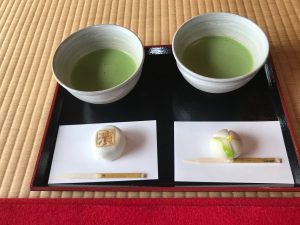How to drink Matcha Tea? What makes it different?
Written by Keiko, February 2021
I am practicing the Japanese tea ceremony for over 25 years and I am running a tea ceremony workshop in London for 5 years. I have received lots of questions about matcha tea, so I wanted to answer as many of the practical ones as I can, and I am hoping much of this information will be interesting to everyone.
What is it that makes matcha tea different?
For the finest matcha tea, farmers go to a great deal of bother to shade their tea leaves from strong sunlight, which considerably slows down the growing process. They do this with the use of reed screens. This slowing of the growth process produces very soft tender leaves, which contain exceptional amounts of Vitamin C, and the sought-after umami taste.
For more everyday grade matcha tea, the screens are not used, which means tea can be produced more quickly, though the leaves are not as tender and the taste is more bitter. Normal tea makers will harvest three times a year without shade and top makers will harvest just once a year with the screens, (which is why fine match tea is more expensive).
For our matcha tea collection, we sell only premium and ceremonial grade of matcha tea. All our teas are produced with farmers with shade.
Can I drink matcha tea with milk?
Yes, you can drink matcha as a matcha latte, or like green tea without milk. If you like matcha latte, you won’t get so much of the umami taste and the natural sweetness of the matcha, as the taste of the milk will be quite powerful, but it can be a delicious drink. For a matcha latte, you can use a reasonable matcha from the collection.
Is there a good time to drink Matcha tea?
Matcha tea contains quite a lot of caffeine, which is a stimulant and can keep some people awake. So I drink matcha tea in the mornings, and generally before 15:00. After that time, I only tend to drink low caffeine matcha tea, so I can be sure of sleeping well at night.
Does matcha tea need to be whisked?
Matcha tea is quite different from normal green tea. Matcha is prepared as a powder tea, so it has to be hydrated and frothed for it to be enjoyed. Its taste is extremely delicate, so it’s best to use water that is not quite boiling – a temperature of 80 degrees is recommended – and then for the mixture to be whisked. I recommend to mix with a bamboo whisk, which give you mild and slightly foamy texture.
Do the Japanese put sugar in green tea?
No, we don’t tend to put any sugar – or milk – in green tea, or in matcha tea. We do, though, eat sweets when drinking some types of green tea, and traditionally, as part of having a cup of matcha tea, there are special sweets we have as part of the experience. I personally love matcha ice-cream though.
What is the best matcha for me?
If you like matcha latte, I would recommend Kitsho as it is slightly bitter, which has perfect harmony with some milk. If you drink matcha as alternative of espresso, I would recommend Kinrin. Kinrin has deep taste as well as slight bitterness.
I do hope some of this is useful! I will be posting some more practical information for green tea lovers later on. Do let me know if you have any more questions. I’ll be happy to answer them when I can.

